The author’s views in this article on competitor analysis for SEO are entirely his own and may not always reflect the views of Ranking By SEO.
SEO is one of the most important strategies used by businesses to ensure continued growth. Not only can it improve your website’s search rankings but also increase organic traffic. Almost 30% of all website’s traffic is generally organic. It also accounts for 20%-25% of conversions.
However, before you plan your SEO strategies, you must conduct a thorough competitor analysis. With the help of the insights you gather from this analysis, you can understand strong and weak nerves of your competitors. And it will also help you design your own SEO strategies accordingly.
Deciding the parameters to use for competitor analysis for SEO can be a tricky job. Also, there are numerous SEO tools available for competitor analysis. And you need to figure out which ones would be the most appropriate ones for you.
This might sound quite daunting. But worry not.
In this article, we’ll discuss how to conduct a competitor analysis for SEO in very simple steps.
1. Identify Keywords
Identification of keywords needs to be the first step towards analyzing your competitors. Keyword research will help you understand what your competitors are up to, from an SEO perspective.
But how do you conduct a keyword research? There’s no need to worry, just follow the steps explained below.
Step 1: Start the process by making a list of all possible topics relevant to your business. Narrow down the list to 5-10 topics which you think are the most important.
Step 2: Then start jotting down the keywords related to these topics. Ensure you search for keywords which are important to enhance your rankings in the SERPs. Think of the ones your target audiences are likely to use to search for your services and products.
Step 3: Ensure you have a good mix of head terms and long-tail keywords. While short terms can generate greater volumes, long-tail keywords can generate quality traffic for your website. So, a balanced mix of keywords will help you achieve your SEO goals.
Step 4: Cross-check your competitor’s rankings with your list of keywords. It’s great if your competitors are using the same keywords. That means it can improve your ranking as well. But do not neglect the words which your competitors are not using. It can help you to rank above your competition.
Step 5: There are many free tools available which you can use to find and identify keywords. The main advantage of using Google Keyword Planner is that it gathers all the data from Google directly.
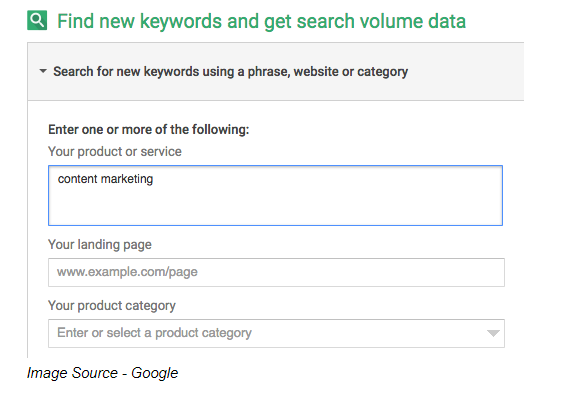
2. Identify Competitors
By now, you must have got a list of relevant keywords with you. Now it’s time to search, find, and create a list of your competitors. Enter the keywords in search engines like Yahoo, Google, or Bing. Then create a list of web pages relevant to your industry, which show up in the top 10 results.
To identify your competitors, you need to analyze these websites. Ensure that you have a good mix of online search competitors and direct business competitors.
There are many tools available for analyzing your competitors.Total traffic and keywords are the most important parameters to be used in this analysis.
3. Analyzing and Tracking the Competitors’ Keywords
After identifying your top competitors, you must analyze their profiles. Start analyzing your competitors using metrics like domain authority, domain age, inbound links, link velocity, social shares etc. Tools like Alexa and Link Research Tools are some of the best tools for website analysis.

You can also use free rank tracking tools like PRT and Tiny Ranker to keep a constant track of your competitors’ rankings and & get comprehensive reports for the same. It shall not only help in tracking your brand’s position online but will also add to keyword suggestions which is a critical factor in itself.
Keeping a track of your competitors paves a way to discover the latest trends in the market and aids in consolidating your own position if measured correctly.
A. Backlink Research
The quality of backlinks is an important ranking aspect. Inbound links to your site help to build trust in your audience’s’ mind. If high authority and quality sites are linking to your site, it indicates that your site is relevant and has quality content. This gives you a greater chance of securing top ranks in SERPs.
There are various tools with the help of which you can analyze the links of your competitor’s site. OpenLinkProfiler and Monitor Backlinks are some well-known tools used to analyze the backlinks.
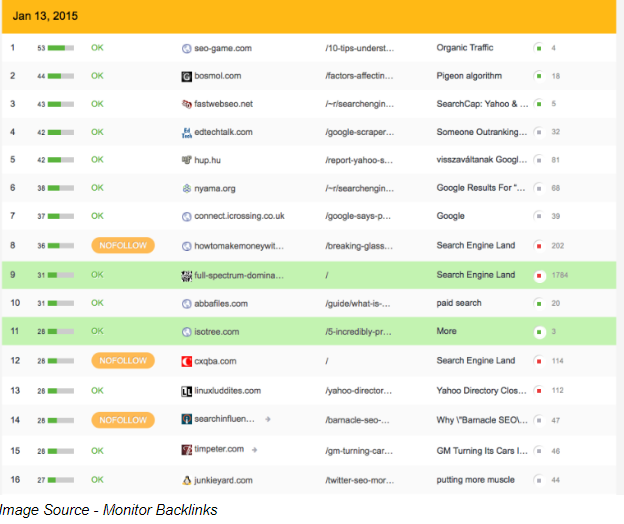
You don’t have to worry if you find some 20,000 links on your competitor’s link report. The numbers alone don’t mean that they are the best in your niche. It is the quality that overpowers.
However, you need to increase the number of inbound links to stay in the competition. Go through the link report of your competitors, scan for new possibilities and opportunities for your own website.
B. Social Media Profiles
The impact of social media on SEO cannot be ignored. A well-planned social media campaign helps brands in building relationships and engage well with customers. It also helps in marketing and increasing brand reach and awareness.
So, find out if your competitors are leveraging social media platforms to promote themselves. At the same time, you too should plan some social media campaigns for your brand.
You can use tools like Likealyzer to check your competitor’s social media activities like engagement rate, social shares etc.
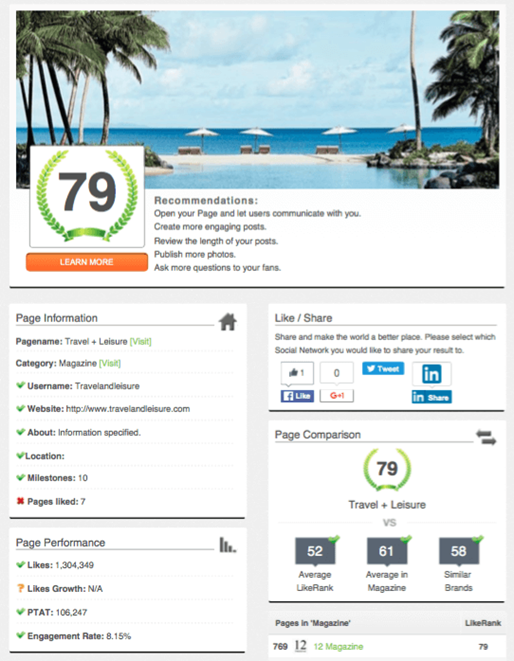
C. Content Audit
A website is likely to have the top ranks on search engines if it carries useful, relevant, and excellent quality content. For the same, you must have a thorough content audit plan for your site as well as for your competitors’.
Parameters like word count, uniqueness, media, and outbound links need to be considered when analyzing the content.
You can use tools like WebConfs or Small SEO Tools to check the density of the keywords on your competitor’s website.
Check if your competitors are using videos and images in their content. Using more videos and images enhances the user experience. Also, outbound links improve the credibility of the content and relationships with your target audience.
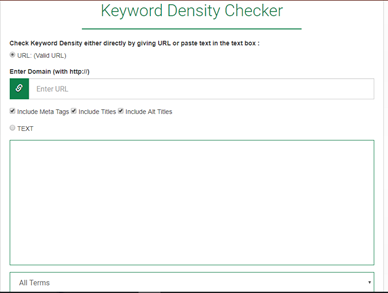
So, see if your competitors are using any outbound links or not. And if they are not using any, grab the opportunity and use it on your site.
D. Determining Domain Authority
Determining the domain authority of your competitor’s site is one of the key aspects of competitor analysis. This analysis will help you set realistic and practical goals for your own website.
You can use Open Site Explorer to know the domain authority of your competitors. This tool will give you detailed information and data on KPIs like page authority, domain authority, social metrics, etc.
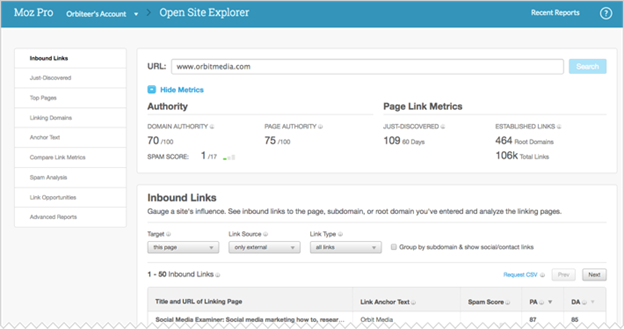
4. Compare with Your Competitors
Once you understand your competitors fully, you need to compare yourself with your competitors. You need to understand what’s working for them and what’s not. This way, you’ll get to know which strategies are worth implementing.
By comparing, you will get an idea of the strengths and weaknesses of your competitors as well as your own. Thorough competitor analysis for SEO is a must to ensure the success your SEO strategies.
Final Thoughts,
This competitor analysis for SEO will help you find out your strengths so you can grow quickly. Competitor analysis gives you the opportunity to learn from your competitors’ failures and successes. These learnings come in handy and can help you stand out from your competition. Based on the competitor analysis report, frame your SEO strategies and watch your business grow.
Can you think of any other ways to conduct competitor analysis for SEO? Let us know in the comments below.

Hi Shane,
Your article is awesome, does it take lot of effort to gain backlinks for website like https://sanctumconsulting.in/ (Visas and immigration) niche?
Sudeesh, gaining high quality links is never an easy task. It is all about your expertise. If you don’t know how to do it effectively, you better hire someone who can do it for you.